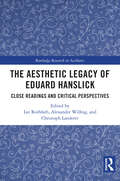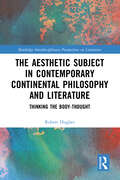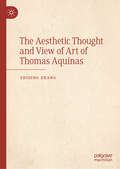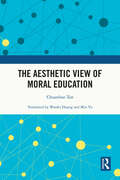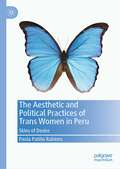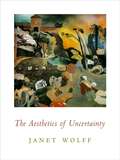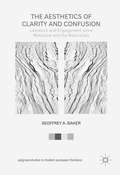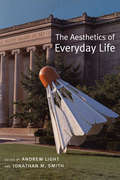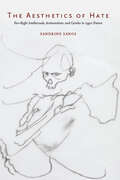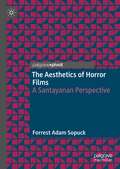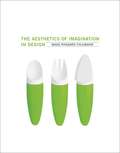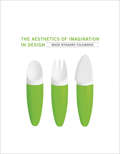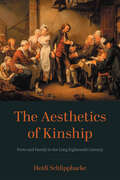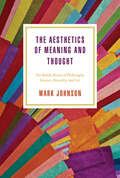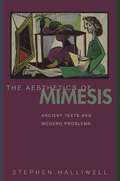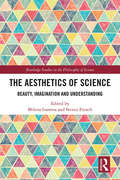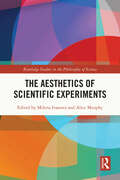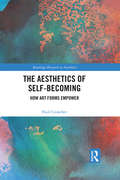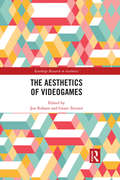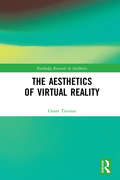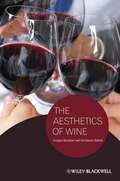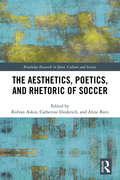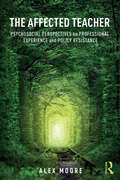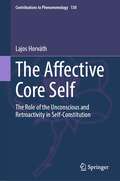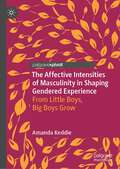- Table View
- List View
The Aesthetic Legacy of Eduard Hanslick: Close Readings and Critical Perspectives (Routledge Research in Aesthetics)
by Lee Rothfarb, Alexander Wilfing, and Christoph LandererThis book addresses the complex conceptual, historical, and philosophical questions posed by Eduard Hanslick’s influential aesthetic treatise, On the Musically Beautiful (1854). The contributions reveal the philosophical foundations and subtleties of his aesthetic approach.The collection features original essays written by leading scholars in philosophical aesthetics and musicology. It covers many of Hanslick’s overarching themes, such as the relationship between beauty and form, between music and emotion, and the role of imagination and performance in music, which have recently gained prominence in Hanslick scholarship. The chapters, divided into five thematic sections, will provide a better scholarly foundation for a deeper understanding of On the Musically Beautiful and its arguments.In bringing together the various approaches and accounts of the different textual, historical, conceptual, and philosophical challenges posed by Hanslick’s aesthetics, The Aesthetic Legacy of Eduard Hanslick will appeal to philosophers of music, historians of aesthetics, musicologists specializing in 19th-century studies, and music theorists working on aesthetic issues.
The Aesthetic Subject in Contemporary Continental Philosophy and Literature: Thinking the Body-Thought (Routledge Interdisciplinary Perspectives on Literature)
by Robert HughesArt makes its mark upon our flesh. It ravishes our eyes, invades our ears, and stirs our viscera; it commandeers our powers of attention and unsettles our body with its strangenesses. The event of art is thus an encounter both with a sensuous object and with ourselves, exposing us as subjects strangely susceptible to being moved.The twenty-first-century European thinkers elucidated here describe a theory of the aesthetic subject: Irigaray articulates the basic outlines of a subject ill at ease with itself. Badiou, Nancy, and Perniola theorize art as an event of deformation that befalls an aesthetic subject fundamentally invested in form. Rancière and Sloterdijk explore the figuration of the body (and its limits) in contexts closer to everyday experience and our life within modern history and politics. This study brings together feminist, psychoanalytic, and phenomenological inheritances to describe the operations of the real in art and aesthetic life.
The Aesthetic Thought and View of Art of Thomas Aquinas
by Zhiqing ZhangThis book examines Aquinas's aesthetic thought and view of art within the broader context of medieval aesthetics and the history of aesthetic development, emphasizing its profound influence on later aesthetics. The book not only elaborates on Aquinas's efforts to establish coherence between faith and reason, the transcendent and empirical, as well as its significance, but also discusses the main contents and characteristics of Aquinas's aesthetic thought from the three aspects of the ontology of beauty, the theory of form, and the theory of experience. By examining Aquinas's aesthetic thought and view of art in relation to modern aesthetics and twentieth-century aesthetics, this book reveals the immense vitality of Aquinas's aesthetic thought.
The Aesthetic View of Moral Education
by Chuanbao TanThe Aesthetic View of Moral Education is the result of in-depth interdisciplinary research in education and aesthetic studies. This book advocates the use of aesthetic ideas and methods to transform moral education activities, which are often trapped in a state of forced indoctrination. This book aims to address the problems of moral education in China and share certain commonalities in the exploration of educational theory. The aesthetic view of moral education is a new and practical philosophy of education. The author's theory of moral education as the appreciation of beauty, the creation of beauty, and the theory of the attainment of the ultimate realm of moral education provide an in-depth analysis of the functions of aesthetic education for moral cultivation. The author also offers unique interpretations of the aesthetic transformation of the process of moral education itself and the pursuit of the realm of moral life and education. This book will be essential reading for students and scholars of education and philosophy, East Asian studies, and readers interested in China's cultural traditions.
The Aesthetic and Political Practices of Trans Women in Peru: Skins of Desire
by Paola Patiño RabinesThis book explores the political-aesthetic practices of transgender women in Lima, Peru, and how they use these to survive and fight for recognition and full citizenship, through drawing on ethnographic research and on decolonial feminist and aesthetic theories. Chapters analyze how the vulnerability and precariousness of trans women coexist with modes of feminist agency, resistance and resilience, as well as with proposals for political action to transform a heteropatriarchal society toward a more diverse and accepting one. Finally, the author draws on the Viennese artist Friedensreich Hundertwasser’s metaphor of the five skins, whereby the first skin is the epidermis; the second is the clothes; the third is the house; the fourth is identity, which refers to primary socialization spaces such as the neighbourhood; and the fifth is the world environment. The author uses this metaphor to analyze the corporal practices of trans women in a cumulative way, paying special attention to the different stages of their lives, to those skins that embody and accompany them from childhood to adulthood.This book will be of interest to scholars of transgender studies, decolonial feminist studies, and aesthetic, particularly those with a focus on gender and sexuality in Latin America.
The Aesthetics Of Uncertainty (Columbia Themes In Philosophy, Social Criticism, And The Arts Ser.)
by Janet WolffThe Aesthetics of Clarity and Confusion
by Geoffrey A. BakerWhat should literature with political aims look like? This book traces two rival responses to this question, one prizing clarity and the other confusion, which have dominated political aesthetics since the late nineteenth century. Revisiting recurrences of the avant-garde experimentalism versus critical realism debates from the twentieth century, Geoffrey A. Baker highlights the often violent reductions at work in earlier debates. Instead of prizing one approach over the other, as many participants in those debates have done, Baker focuses on the manner in which the debate itself between these approaches continues to prove productive and enabling for politically engaged writers. This book thus offers a way beyond the simplistic polarity of realism vs. anti-realism in a study that is focused on influential strands of thought in England, France, and Germany and that covers well-known authors such as Zola, Nietzsche, Arnold, Mann, Brecht, Sartre, Adorno, Lukács, Beauvoir, Morrison, and Coetzee.
The Aesthetics of Everyday Life (Spaces, Places And Environments Ser.)
by Jonathan Smith Andrew LightThe aesthetics of everyday life, originally developed by Henri Lefebvre and other modernist theorists, is an extension of traditional aesthetics, usually confined to works of art. It is not limited to the study of humble objects but is rather concerned with all of the undeniably aesthetic experiences that arise when one contemplates objects or performs acts that are outside the traditional realm of aesthetics. It is concerned with the nature of the relationship between subject and object.One significant aspect of everyday aesthetics is environmental aesthetics, whether constructed, as a building, or manipulated, as a landscape. Others, also discussed in the book, include sport, weather, smell and taste, and food.
The Aesthetics of Hate: Far-Right Intellectuals, Antisemitism, and Gender in 1930s France
by Sandrine SanosThe Aesthetics of Hate examines the writings of a motley collection of interwar far-right French intellectuals, showing that they defined Frenchness in racial, gendered, and sexual terms.
The Aesthetics of Horror Films: A Santayanan Perspective
by Forrest Adam SopuckThis book analyzes the nature and functions of horror films from the vantage of a theoretical reconstruction of George Santayana’s account of beauty. This neo-Santayanan framework forms the conceptual backdrop for a new model of horror’s aesthetic enjoyment, the nature of which is detailed through the examination of plot, cinematic, and visual devices distinctive of the popular genre. According to this model, the audience derives pleasure from the films through confronting the aversive scenarios they communicate and rationalizing a denial of their personal applicability. The films then come to embody these acts of self-assertion and intellectual overcoming and become objects of pride. How horror films can acquire necropolitical functions within the context of abusive systems of power is also clarified. These functions, which exploit the power of anti-tragedy, downward social comparison, or vicarious emotion, work to remediate aggressive, ascetic, or revolutionary impulses in ways that are not injurious to the status quo. This book champions horror as a source of self-empowerment and unmitigated beauty, but also attests to the potential social harms of the genre.
The Aesthetics of Imagination in Design
by Mads Nygaard FolkmannIn The Aesthetics of Imagination in Design, Mads Folkmann investigates design in both material and immaterial terms. Design objects, Folkmann argues, will always be dual phenomena -- material and immaterial, sensual and conceptual, actual and possible. Drawing on formal theories of aesthetics and the phenomenology of imagination, he seeks to answer fundamental questions about what design is and how it works that are often ignored in academic research. Folkmann considers three conditions in design: the possible, the aesthetic, and the imagination. Imagination is a central formative power behind the creation and the life of design objects; aesthetics describes the sensual, conceptual, and contextual codes through which design objects communicate; the concept of the possible -- the enabling of new uses, conceptions, and perceptions -- lies behind imagination and aesthetics. The possible, Folkmann argues, is contained as a structure of meaning within the objects of design, which act as part of our interface with the world. Taking a largely phenomenological perspective that reflects both continental and American pragmatist approaches, Folkmann also makes use of discourses that range from practice-focused accounts of design methodology to cultural studies. Throughout, he offers concrete examples to illustrate theoretical points. Folkmann's philosophically informed account shows design -- in all its manifestations, from physical products to principles of organization -- to be an essential medium for the articulation and transformation of culture.
The Aesthetics of Imagination in Design (Design Thinking, Design Theory)
by Mads Nygaard FolkmannA theoretically informed investigation that relates the philosophies of aesthetics and imagination to understanding design practice.In The Aesthetics of Imagination in Design, Mads Folkmann investigates design in both material and immaterial terms. Design objects, Folkmann argues, will always be dual phenomena—material and immaterial, sensual and conceptual, actual and possible. Drawing on formal theories of aesthetics and the phenomenology of imagination, he seeks to answer fundamental questions about what design is and how it works that are often ignored in academic research.Folkmann considers three conditions in design: the possible, the aesthetic, and the imagination. Imagination is a central formative power behind the creation and the life of design objects; aesthetics describes the sensual, conceptual, and contextual codes through which design objects communicate; the concept of the possible—the enabling of new uses, conceptions, and perceptions—lies behind imagination and aesthetics. The possible, Folkmann argues, is contained as a structure of meaning within the objects of design, which act as part of our interface with the world. Taking a largely phenomenological perspective that reflects both continental and American pragmatist approaches, Folkmann also makes use of discourses that range from practice-focused accounts of design methodology to cultural studies. Throughout, he offers concrete examples to illustrate theoretical points. Folkmann's philosophically informed account shows design—in all its manifestations, from physical products to principles of organization—to be an essential medium for the articulation and transformation of culture.
The Aesthetics of Kinship: Form and Family in the Long Eighteenth Century (New Studies in the Age of Goethe)
by Heidi SchlipphackeThe Aesthetics of Kinship intervenes critically into rigidified discourses about the emergence of the nuclear family and the corresponding interior subject in the eighteenth century. By focusing on kinship constellations instead of “family plots” in seminal literary works of the period, this book presents an alternative view of the eighteenth-century literary social world and its concomitant ideologies. Whereas Enlightenment and post-Enlightenment philosophy and political theory posit the nuclear family as a microcosm for the ideal modern nation-state, literature of the period offers a far more heterogeneous image of kinship structures, one that includes members of various classes and is not defined by blood. Through a radical re-reading of the multifarious kinship structures represented in literature of the long eighteenth century, The Aesthetics of Kinship questions the inevitability of the dialectic of the Enlightenment and invokes alternative futures for conceptions of social and political life.
The Aesthetics of Meaning and Thought: The Bodily Roots of Philosophy, Science, Morality, and Art
by Mark JohnsonAll too often, we think of our minds and bodies separately. The reality couldn’t be more different: the fundamental fact about our mind is that it is embodied. We have a deep visceral, emotional, and qualitative relationship to the world—and any scientifically and philosophically satisfactory view of the mind must take into account the ways that cognition, meaning, language, action, and values are grounded in and shaped by that embodiment. This book gathers the best of philosopher Mark Johnson’s essays addressing questions of our embodiment as they deal with aesthetics—which, he argues, we need to rethink so that it takes into account the central role of body-based meaning. Viewed that way, the arts can give us profound insights into the processes of meaning making that underlie our conceptual systems and cultural practices. Johnson shows how our embodiment shapes our philosophy, science, morality, and art; what emerges is a view of humans as aesthetic, meaning-making creatures who draw on their deepest physical processes to make sense of the world around them.
The Aesthetics of Mimesis: Ancient Texts and Modern Problems
by Stephen HalliwellMimesis is one of the oldest, most fundamental concepts in Western aesthetics. This book offers a new, searching treatment of its long history at the center of theories of representational art: above all, in the highly influential writings of Plato and Aristotle, but also in later Greco-Roman philosophy and criticism, and subsequently in many areas of aesthetic controversy from the Renaissance to the twentieth century. Combining classical scholarship, philosophical analysis, and the history of ideas--and ranging across discussion of poetry, painting, and music--Stephen Halliwell shows with a wealth of detail how mimesis, at all stages of its evolution, has been a more complex, variable concept than its conventional translation of "imitation" can now convey. Far from providing a static model of artistic representation, mimesis has generated many different models of art, encompassing a spectrum of positions from realism to idealism. Under the influence of Platonist and Aristotelian paradigms, mimesis has been a crux of debate between proponents of what Halliwell calls "world-reflecting" and "world-simulating" theories of representation in both the visual and musico-poetic arts. This debate is about not only the fraught relationship between art and reality but also the psychology and ethics of how we experience and are affected by mimetic art. Moving expertly between ancient and modern traditions, Halliwell contends that the history of mimesis hinges on problems that continue to be of urgent concern for contemporary aesthetics.
The Aesthetics of Science: Beauty, Imagination and Understanding (Routledge Studies in the Philosophy of Science)
by Steven French Milena IvanovaThis volume builds on two recent developments in philosophy on the relationship between art and science: the notion of representation and the role of values in theory choice and the development of scientific theories. Its aim is to address questions regarding scientific creativity and imagination, the status of scientific performances—such as thought experiments and visual aids—and the role of aesthetic considerations in the context of discovery and justification of scientific theories. Several contributions focus on the concept of beauty as employed by practising scientists, the aesthetic factors at play in science and their role in decision making. Other essays address the question of scientific creativity and how aesthetic judgment resolves the problem of theory choice by employing aesthetic criteria and incorporating insights from both objectivism and subjectivism. The volume also features original perspectives on the role of the sublime in science and sheds light on the empirical work studying the experience of the sublime in science and its relation to the experience of understanding. The Aesthetics of Science tackles these topics from a variety of novel and thought-provoking angles. It will be of interest to researchers and advanced students in philosophy of science and aesthetics, as well as other subdisciplines such as epistemology and philosophy of mathematics.
The Aesthetics of Scientific Experiments (Routledge Studies in the Philosophy of Science)
by Milena Ivanova Alice MurphyThe relationship between aesthetics and science has begun to generate substantial interest. However, for the most part, the focus has been on the beauty of theories, and other aspects of scientific practice have been neglected. This book offers a novel perspective on aesthetics in experimentation via ten original essays from an interdisciplinary group comprised of philosophers, historians of science and art, and artists. The collection provides an analysis of the concept of beauty in the evaluation of experiments. What properties do practicing experimenters value? How have the aesthetic properties of scientific experiments changed over the years? Secondly, the volume looks at the role that aesthetic factors, including negative values such as ugliness, as well as experiences of the sublime and the profound, play in the construction of an experiment and its reception. Thirdly, the chapters provide in-depth historical case studies from the Royal Society, which also allows for a study of the depiction of scientific experiment in artworks, as well as contemporary examples from the LHC and cases of AI-designed experiments. Finally, it offers a exploration of the commonalities between how we learn from experiments on the one hand, and the cognitive value of artworks on the other. The Aesthetics of Scientific Experiments will be of interest to researchers and advanced students working in philosophy and history of science, and philosophy and history of art, as well as practicing scientists.
The Aesthetics of Self-Becoming: How Art Forms Empower (Routledge Research in Aesthetics)
by Paul CrowtherThis book shows that art involves an aesthetics of self-becoming, wherein we do not simply consume artistic meaning, but become empowered—by adapting ourselves to what creation in the different art forms makes possible. Paul Crowther argues that the great political task in aesthetics is no longer the creation of political art as such, but rather the winning back of art and aesthetics as central societal concerns. This involves the overcoming of neo-liberal treatments of art as mere commodity and misguided attitudes that dismiss it as the product of dead white European males. The book begins with a theory of self-consciousness which reveals the necessary role played by the aesthetic in personal identity. It then emphasises how art forms empower through processes of making and aesthetic effects that are unique to them individually. To show this, he considers the ontology of pictorial art, sculpture, installation and assemblage works, architecture, literature, cinema, and music. His arguments concerning these are supported, throughout, by in-depth discussions of specific artworks. The book’s effect, overall is to reorientate aesthetics by showing how art empowers through its revelation of new possibilities of experience. The Aesthetics of Self-Becoming will appeal to philosophers of art and aesthetics, as well as scholars in art history, literary studies, film studies, and music theory who are interested in the book’s central concerns.
The Aesthetics of Videogames (Routledge Research in Aesthetics)
by Jon Robson Grant TavinorThis collection of essays is devoted to the philosophical examination of the aesthetics of videogames. Videogames represent one of the most significant developments in the modern popular arts, and it is a topic that is attracting much attention among philosophers of art and aestheticians. As a burgeoning medium of artistic expression, videogames raise entirely new aesthetic concerns, particularly concerning their ontology, interactivity, and aesthetic value. The essays in this volume address a number of pressing theoretical issues related to these areas, including but not limited to: the nature of performance and identity in videogames; their status as an interactive form of art; the ethical problems raised by violence in videogames; and the representation of women in videogames and the gaming community. The Aesthetics of Videogames is an important contribution to analytic aesthetics that deals with an important and growing art form.
The Aesthetics of Virtual Reality (Routledge Research in Aesthetics)
by Grant TavinorThis is the first book to present an aesthetics of virtual reality media. It situates virtual reality media in terms of the philosophy of the arts, comparing them to more familiar media such as painting, film and photography. When philosophers have approached virtual reality, they have almost always done so through the lens of metaphysics, asking questions about the reality of virtual items and worlds, about the value of such things, and indeed, about how they may reshape our understanding of the "real" world. Grant Tavinor finds that approach to be fundamentally mistaken, and that to really account for virtual reality, we must focus on the medium and its uses, and not the hypothetical and speculative instances that are typically the focus of earlier works. He also argues that much of the cultural and metaphysical hype around virtual reality is undeserved. But this does not mean that virtual reality is illusory or uninteresting; on the contrary, it is significant for the altogether different reason that it overturns much of our understanding of how representational media can function and what we can use them to achieve. The Aesthetics of Virtual Reality will be of interest to scholars and advanced students working in aesthetics, philosophy of art, philosophy of technology, metaphysics, and game studies.
The Aesthetics of Wine
by Ole M. Skilleas Douglas BurnhamThe Aesthetics of Wine shows that discussing wine within the framework of aesthetics both benefits our understanding of wine as a phenomenon, while also challenging some of the basic assumptions of the tradition of aesthetics.Analyzes the appreciation of wine as an aesthetic practice. Tackles prejudices against bodily senses, showing how they distort traditional aesthetic theory Represents the beginnings of a reformulation of general aesthetics
The Aesthetics, Poetics, and Rhetoric of Soccer (Routledge Research in Sport, Culture and Society)
by Ridvan Askin Catherine Diederich Aline BieriSoccer has long been known as 'the beautiful game'. This multi-disciplinary volume explores soccer, soccer culture, and the representation of soccer in art, film, and literature, using the critical tools of aesthetics, poetics, and rhetoric. Including international contributions from scholars of philosophy, literary and cultural studies, linguistics, art history, and the creative arts, this book begins by investigating the relationship between beauty and soccer and asks what criteria should be used to judge the sport’s aesthetic value. Covering topics as diverse as humor, national identity, style, celebrity, and social media, its chapters examine the nature of fandom, the role of language, and the significance of soccer in contemporary popular culture. It also discusses what one might call the ‘stylistics’ of soccer, analyzing how players, fans, and commentators communicate on and off the pitch, in the press, on social media, and in wider public discourse. The Aesthetics, Poetics, and Rhetoric of Soccer makes for fascinating reading for anybody with an interest in sport, culture, literature, philosophy, linguistics, and society.
The Affected Teacher: Psychosocial Perspectives on Professional Experience and Policy Resistance
by Alex MooreAt a time when teaching and learning policy too often presents itself in a simplistic input-output language of measurable targets and objectives, The Affected Teacher explores the role played by emotionality in how professional life is experienced by school teachers. The book argues that, in the very highly organised and structured social spaces of public institutions, emotionality - or, more precisely, all that is included in the concept of ‘affect’ - needs to be recognised and validated, rather than ignored or pathologised. It explores how neoliberal education policy seeks to mould professional subjectivities, relationships and practices; how teachers experience and ‘manage’ their feelings; and the role that affect plays in guiding either compliance with or resistance to often unpopular policy directives. Drawing on a rich body of original data comprising formal and informal discussions with a range of teachers, the case is argued for psychoanalytically and politically informed individual and group reflexivity, both as a form of professional and personal development and as a way of keeping alive alternative beliefs and understandings regarding the purposes of education. The Affected Teacher is relevant to practising schoolteachers and to undergraduate and graduate students and academics involved in education related courses such as policy studies, education management and the sociology of education, as well as disciplines related to psychosocial studies and psychoanalysis.
The Affective Core Self: The Role of the Unconscious and Retroactivity in Self-Constitution (Contributions to Phenomenology #130)
by Lajos HorváthThis book extends the contemporary concept of the minimal self by introducing the affective core self. The overall aim is to integrate certain psychoanalytical ideas into the phenomenological investigation of passivity and reformulate the idea of the phenomenological unconscious. This volume contributes to the multidimensional analysis of the self by positioning the affective core self between the layers of the more minimal and the less minimal self. It underscores the importance of the unconscious in the constitution of the affective core self by providing the comparative analysis of the phenomenological and the psychoanalytical unconscious.Furthermore, comparisons are drawn between Freud’s conception of the afterwardsness of trauma and the phenomenological notion of retroactive sense-constitution. The book concludes that retroactive sense-making is a double-sided phenomenon and differentiates between implicit-bodily and conscious-narrative retroactive sense-constitution. In order to bolster the idea of implicit-bodily sense-constitution the volume also examines and utilizes contemporary insights on the nature of body memory. The conclusion claims that the affective core self is constituted in time by means of the underlying processes of the two-sided retroactive sense-constitution. This text appeals to students and researchers working in phenomenology and philosophy of mind.
The Affective Intensities of Masculinity in Shaping Gendered Experience: From Little Boys, Big Boys Grow
by Amanda KeddieThis book tells a story of masculinity through the experiences of one boy, ‘Adam’. From four different studies and time periods, it tracks moments of significance in his life over a period of 20 years. These moments highlight the ways in which Adam is both drawn towards and away from a hegemonic masculinity of physical toughness, domination, competition and an opposition to ‘the feminine’. The book is set against the backdrop of a long history of contentious gender politics in Australia and globally but particularly responds to the renewed attention to the social construction of masculinities in the current #MeToo climate. Against this backdrop, nuanced and longitudinal accounts of boys’ and men’s experiences of masculinity are significant because they can offer insight into the complex bodily, social, economic, and historical forces that configure masculinities. Such understandings are important in our endeavours as those who educate, support and work with boys and men to transform gender inequalities.
